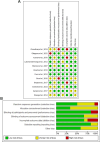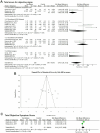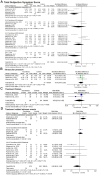The impact of tacrolimus therapy on the outcomes of vernal keratoconjunctivitis: a systematic review and meta-analysis
- PMID: 40809423
- PMCID: PMC12343550
- DOI: 10.3389/fmed.2025.1542440
The impact of tacrolimus therapy on the outcomes of vernal keratoconjunctivitis: a systematic review and meta-analysis
Abstract
Background: Various preparations of tacrolimus have been implemented for patients with vernal keratoconjunctivitis (VKC). However, there is a lack of evidence regarding the safety and effectiveness of different dosages and forms of tacrolimus for patients with VKC.
Objective: The present systematic review and meta-analysis evaluated the safety and effectiveness of various dosages and forms of tacrolimus for patients with VKC.
Methods: The literature review was performed through 12 databases on 15 June 2024. All clinical studies comparing the outcomes of different dosages and tacrolimus preparations for VKC were included. Subgroup analysis was performed based on the dosages and formulations of tacrolimus.
Results: The present meta-analysis included 17 articles, encompassing 832 patients with VKC. Of them, 421 patients received tacrolimus, while 411 patients were in the control group. Of the treated patients with tacrolimus, 66 were treated with tacrolimus ophthalmic suspension 0.1%, and 62 were treated with tacrolimus 0.1% ointment. Furthermore, 293 patients were treated with tacrolimus 0.03% ointment. There was a statistically significant (p = 0.02) difference between tacrolimus and the control group regarding the mean score for objective signs with SMD of -0.70 (95%CI:-1.28, -0.13). A statistically significant difference (p < 0.001) was observed between the tacrolimus ophthalmic suspension 0.1% and the control group with an SMD of -1.09 (95%CI:-1.59, -0.59). There was a significantly lower total subjective symptom score among patients treated with tacrolimus with an SMD of -0.86 (95%CI:-1.44, 0.28) and a probability value of 0.004. A statistically significant lower risk of treatment-related adverse events was revealed among patients treated with tacrolimus 0.03% ointment (p = 0.0002) with an RR of 0.16.
Conclusion: Tacrolimus is an effective and safe therapeutic intervention for patients with VKC. It remarkably reduced the total score for objective signs and total subjective symptom score of VKC, with a relatively lower risk of treatment-related adverse events. The improvement of clinical manifestations was significantly associated with tacrolimus ophthalmic suspension 0.1%, while tacrolimus 0.03% ointment was associated with the lowest risk of treatment-related adverse events.
Keywords: VKC; ointment; suspension; tacrolimus; vernal keratoconjunctivitis.
Copyright © 2025 AlHuthail.
Conflict of interest statement
The author declares that the research was conducted in the absence of any commercial or financial relationships that could be construed as a potential conflict of interest.
Figures




Similar articles
-
Systemic pharmacological treatments for chronic plaque psoriasis: a network meta-analysis.Cochrane Database Syst Rev. 2017 Dec 22;12(12):CD011535. doi: 10.1002/14651858.CD011535.pub2. Cochrane Database Syst Rev. 2017. Update in: Cochrane Database Syst Rev. 2020 Jan 9;1:CD011535. doi: 10.1002/14651858.CD011535.pub3. PMID: 29271481 Free PMC article. Updated.
-
Systemic pharmacological treatments for chronic plaque psoriasis: a network meta-analysis.Cochrane Database Syst Rev. 2021 Apr 19;4(4):CD011535. doi: 10.1002/14651858.CD011535.pub4. Cochrane Database Syst Rev. 2021. Update in: Cochrane Database Syst Rev. 2022 May 23;5:CD011535. doi: 10.1002/14651858.CD011535.pub5. PMID: 33871055 Free PMC article. Updated.
-
Prescription of Controlled Substances: Benefits and Risks.2025 Jul 6. In: StatPearls [Internet]. Treasure Island (FL): StatPearls Publishing; 2025 Jan–. 2025 Jul 6. In: StatPearls [Internet]. Treasure Island (FL): StatPearls Publishing; 2025 Jan–. PMID: 30726003 Free Books & Documents.
-
Systemic pharmacological treatments for chronic plaque psoriasis: a network meta-analysis.Cochrane Database Syst Rev. 2020 Jan 9;1(1):CD011535. doi: 10.1002/14651858.CD011535.pub3. Cochrane Database Syst Rev. 2020. Update in: Cochrane Database Syst Rev. 2021 Apr 19;4:CD011535. doi: 10.1002/14651858.CD011535.pub4. PMID: 31917873 Free PMC article. Updated.
-
A systematic review and economic model of the clinical and cost-effectiveness of immunosuppressive therapy for renal transplantation in children.Health Technol Assess. 2006 Dec;10(49):iii-iv, ix-xi, 1-157. doi: 10.3310/hta10490. Health Technol Assess. 2006. PMID: 17134597
References
Publication types
LinkOut - more resources
Full Text Sources

